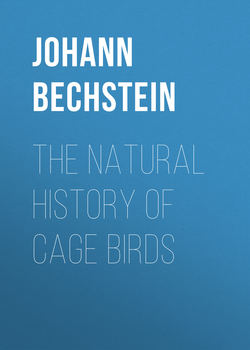Читать книгу The Natural History of Cage Birds - Bechstein Johann Matthäus - Страница 13
PIES
THE LITTLE SHRIKE
ОглавлениеLanius minor, Linnæus; Der graue Würger, Bechstein
It is about the size of the sky-lark, being eight inches in length, of which the tail measures three and a half, the folded wings cover one-third. The beak is black, and seven inches in length; the iris brown; the legs of a lead-colour; the forehead black; a broad streak of the same colour passing from the beak across the eyes and over the cheeks; the tail is wedge-shaped; the exterior feathers are white, with a black spot.
The female only differs from the male in being a little smaller, the streak on the cheeks is shorter and narrower, and there is generally only one white feather in the tail.
Habitation. – Wild, it is a bird of passage, departing the first of September, and returning the beginning of the following May15. It generally frequents woods, orchards, and the hedges of fields. Always perched on the tops of trees, it rarely descends into the lower bushes. It feeds on insects.
In the house, it must have a large wire cage like the larks, but with three perches. It is not safe to let it mix with the other birds, as it would soon kill them.
Food. – In its wild state it feeds on beetles, cockchafers, crickets, breeze-flies, and other insects; when these fail, in consequence of a long continuance of rain, it sometimes seizes young birds.
In the house, if an old bird and lately taken, as soon as it is put in the cage, some living insects, or a small bird just killed, must be thrown into it. After some time, it will be satisfied with raw or dressed meat; but it is not always an easy task to get it to eat this food, for it will sometimes take eight successive days, during which meal worms and other insects are added; but as soon as it is accustomed to meat, it becomes so tame that it will feed from the hand, and if the cage door be opened it will even perch on the wrist to eat. Notwithstanding all my care, I have only been able to preserve those two years, which have been taken wild, they have all died of decline16; those, on the contrary, which have been reared from the nest, do not require so much attention, being contented with any kind of common food.
Breeding. – This bird generally builds in a tree on the edge of a wood, or in a garden, the nest being rather large and irregular. The young are fed on beetles and grasshoppers. In order to rear them, they must be taken from the nest when the tail begins to grow, and fed at first on ants' eggs, and afterwards on white bread soaked in milk.
Mode of Taking. – When the particular brambles and branches have been observed, on which this bird watches for its prey, it is not difficult to catch it; for notwithstanding its great quickness, it is not the less imprudent, for it allows itself to be caught in the bird-lime in the most stupid manner.
Attractive Qualities. – This species has no particular song: the female has none at all; but the male imitates, with wonderful facility, the songs of other birds, not only the detached parts, but the whole notes, so correctly that it would not be difficult to mistake it. Thus it imitates exactly, and in order, all the variations of the song of the nightingale, though more feebly, and like an echo, its notes not being so full and clear: it imitates equally well the song of the lark, and similar birds. This wonderful power of imitation cannot fail to please amateurs, and make them wish to possess this interesting bird. I have observed that it likes best to repeat the call of the quail. One of this species which I had among my collection, always stopped its song, however lively, when it heard that of the quail, for the purpose of imitating it; the latter, before it was accustomed to this, became very jealous, and as soon as it heard it, ran about in every direction, furiously endeavouring to fight its fancied rival.
15
It is not a native of Britain. – Translator.
16
Perhaps from not having been given now and then feathers, the fur and skin of animals, or even beetles, to cleanse the stomach. – Translator.
